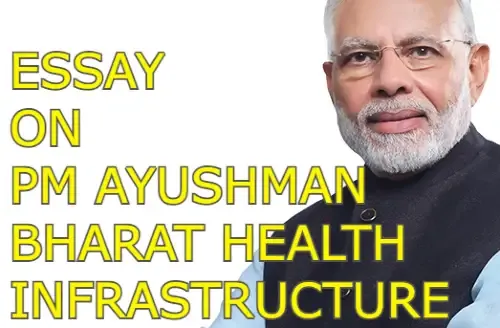ESSAY ON PM AYUSHMAN BHARAT HEALTH INFRASTRUCTURE MISSION
Why is this in the news?
The Prime Minister visited Varanasi, Uttar Pradesh, which is being touted as India's biggest plan to enhance health infrastructure. PM also inaugurated nine medical colleges in Uttar Pradesh under PM Ayushman Bharat Health Infrastructure Mission.
What is Ayushman Bharat Health Infrastructure Mission?
Pradhan Mantri Ayushman and India Health Infrastructure Mission is one of the biggest pan-India schemes to strengthen healthcare infrastructure across the country.
It is a Centrally Sponsored Scheme or CSS. CSS is a shared cost program and its objective is to ensure a minimum standard of service across the country. Under this scheme, preference is given to backward and aspirational districts.
The objective of the scheme is to increase the availability of health professionals, correct the existing geographical imbalance in the distribution of medical colleges and effectively utilize the existing infrastructure of district hospitals.
Under the Centrally Sponsored Scheme, eight medical colleges have been sanctioned for establishment of new medical colleges attached to district or referral hospitals, and one medical college at John Poole has been operated by the State Government through its own resources.
Objectives and objectives of Ayushman Bharat Health Infrastructure Mission.
The Ayushman Bharat Health Infrastructure Mission aims to fill critical gaps in public health infrastructure, particularly in critical care facilities and primary care, both in urban and rural areas.
The mission will support 17,788 rural health and wellness centres in ten high focus states and establish 1124 urban health major wellness centres across the country.
This will ensure access to critical care services in all the districts of our five lakh population country through specialized critical care hospital blocks. The objective of the mission is to establish an efficient disease surveillance system through a network of surveillance laboratories at the block, district, regional and national levels.
All public health laboratories will be linked through a unified health information portal, which will be expanded to all states and union territories.
One National Institute for Health, four new National Institutes for Virology, a regional research platform for the Hu South East Asia region, nine biosafety levels, three laboratories and five new regional National Centers for Disease Control will be set up under the plan.
PMASBY aims to operationalize 17 new public health units and strengthen 33 existing public health units at points of entry to effectively detect, investigate, prevent and combat public health emergencies and disease outbreaks.
Now let's move on to the importance
A 2019 study titled the State of Democracy in South Asia SDSA Round Three by Lok Nidhi CSDS highlighted how access to public health care remained elusive for marginalized people.
The study found that 70% of the locations have public health care services. However, availability was lower in rural areas, which is 65% compared to urban areas, in 45% of the locations surveyed, people could access health services on foot, while 43% needed to use transport was, Therefore, we can say that India has needed a universal health care system for a long time.
Also read: Essay on Atmanirbhar Bharat
Also read: Essay on Competition Law in New India-Building Atmanirbhar Bharat
Also read: Essay on E-RUPI Digital Payment
Also read: Essay on Veer gatha project on Nirmal jit Singh Sekhon
THANK YOU SO MUCH

Comments
Post a Comment